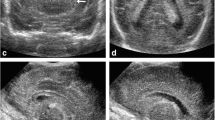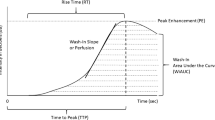Abstract
Brain ultrasound has become a critical tool for bedside screening and monitoring of hypoxic-ischemic injury in infants. Transfontanellar ultrasound in infants allows delineation of anatomical structures of the brain and posterior fossa. The technique’s low cost, lack of ionizing radiation and repeatability make it a popular alternative to magnetic resonance imaging. The published literature on interpreting hypoxic-ischemic injury on brain ultrasound is wide and varied, yet diagnostic challenges remain when detecting subtle or diffuse changes. This pictorial essay summarizes and illustrates the spectrum of sonographic findings of hypoxic-ischemic injuries in term infants.















Similar content being viewed by others
References
Barkovich AJ (1997) The encephalopathic neonate: choosing the proper imaging technique. AJNR Am J Neuroradiol 18:1816–1820
Meijler G (2010) Neonatal cranial ultrasonography. Springer-Verlag, Berlin Heidelberg
van Wezel-Meijler G, Steggerda SJ, Leijser LM (2010) Cranial ultrasonography in neonates: role and limitations. Semin Perinatol 34:28–38
Daneman A, Epelman M (2015) Neurosonography: in pursuit of an optimized examination. Pediatr Radiol 45(Suppl 3):S406–S412
Daneman A, Epelman M, Blaser S, Jarrin JR (2006) Imaging of the brain in full-term neonates: does sonography still play a role? Pediatr Radiol 36:636–646
Dinan D, Daneman A, Guimaraes CV et al (2014) Easily overlooked sonographic findings in the evaluation of neonatal encephalopathy: lessons learned from magnetic resonance imaging. Semin Ultrasound CT MR 35:627–651
Epelman M, Daneman A, Kellenberger CJ et al (2010) Neonatal encephalopathy: a prospective comparison of head US and MRI. Pediatr Radiol 40:1640–1650
Cotten CM, Shankaran S (2010) Hypothermia for hypoxic-ischemic encephalopathy. Expert Rev Obstet Gynecol 5:227–239
Shalak L, Perlman JM (2004) Hypoxic-ischemic brain injury in the term infant-current concepts. Early Hum Dev 80:125–141
Salas J, Tekes A, Hwang M et al (2018) Head ultrasound in neonatal hypoxic-ischemic injury and its mimickers for clinicians: a review of the patterns of injury and the evolution of findings over time. Neonatology 114:185–197
Gopagondanahalli KR, Li J, Fahey MC et al (2016) Preterm hypoxic-ischemic encephalopathy. Front Pediatr 4:114
Volpe JJ (2009) Brain injury in premature infants: a complex amalgam of destructive and developmental disturbances. Lancet Neurol 8:110–124
Chacko A, Andronikou S, Mian A et al (2020) Cortical ischaemic patterns in term partial-prolonged hypoxic-ischaemic injury — the inter-arterial watershed demonstrated through atrophy, ulegyria and signal change on delayed MRI scans in children with cerebral palsy. Insights Imaging 11:53
de Vries LS, Cowan FM (2009) Evolving understanding of hypoxic-ischemic encephalopathy in the term infant. Semin Pediatr Neurol 16:216–225
Cowan F, Rutherford M, Groenendaal F et al (2003) Origin and timing of brain lesions in term infants with neonatal encephalopathy. Lancet 361:736–742
Lally PJ, Montaldo P, Oliveira V et al (2019) Magnetic resonance spectroscopy assessment of brain injury after moderate hypothermia in neonatal encephalopathy: a prospective multicentre cohort study. Lancet Neurol 18:35–45
Hwang M (2018) Introduction to contrast-enhanced ultrasound of the brain in neonates and infants: current understanding and future potential. Pediatr Radiol 49:254–262
Shi Y, Zhao J-N, Liu L et al (2012) Changes of positron emission tomography in newborn infants at different gestational ages, and neonatal hypoxic-ischemic encephalopathy. Pediatr Neurol 46:116–123
de Vries LS, Groenendaal F (2010) Patterns of neonatal hypoxic-ischaemic brain injury. Neuroradiology 52:555–566
Huang BY, Castillo M (2008) Hypoxic-ischemic brain injury: imaging findings from birth to adulthood. Radiographics 28:417–439
Ashwal S, Majcher JS, Longo LD (1981) Patterns of fetal lamb regional cerebral blood flow during and after prolonged hypoxia: studies during the posthypoxic recovery period. Am J Obstet Gynecol 139:365–372
Connolly B, Kelehan P, O'Brien N et al (1994) The echogenic thalamus in hypoxic ischaemic encephalopathy. Pediatr Radiol 24:268–271
Soghier LM, Vega M, Aref K et al (2006) Diffuse basal ganglia or thalamus hyperechogenicity in preterm infants. J Perinatol 26:230–236
Naidich TP, Gusnard DA, Yousefzadeh DK (1985) Sonography of the internal capsule and basal ganglia in infants: 1. Coronal sections. AJNR Am J Neuroradiol 6:909–917
van Wezel-Meijler G, Leijser LM, Wiggers-de Bruine FT et al (2011) Diffuse hyperechogenicity of basal ganglia and thalami in preterm neonates: a physiologic finding? Radiology 258:944–950
Rutherford MA, Pennock JM, Dubowitz LM (1994) Cranial ultrasound and magnetic resonance imaging in hypoxic-ischaemic encephalopathy: a comparison with outcome. Dev Med Child Neurol 36:813–825
Miller SP, Ramaswamy V, Michelson D et al (2005) Patterns of brain injury in term neonatal encephalopathy. J Pediatr 146:453–446
Swarte R, Lequin M, Cherian P et al (2009) Imaging patterns of brain injury in term-birth asphyxia. Acta Paediatr 98:586–592
Epelman M, Daneman A, Chauvin N, Hirsch W (2012) Head ultrasound and MR imaging in the evaluation of neonatal encephalopathy: competitive or complementary imaging studies? Magn Reson Imaging Clin N Am 20:93–115
Yikilmaz A, Taylor GA (2008) Cranial sonography in term and near-term infants. Pediatr Radiol 38:605–616
Leijser LM, de Vries LS, Cowan FM (2006) Using cerebral ultrasound effectively in the newborn infant. Early Hum Dev 82:827–835
Toma P, Granata C (2015) Brain sonography. Springer, Berlin Heidelberg
Winkler P (1998) Advances in paediatric CNS ultrasound. Eur J Radiol 26:109–120
Grant EG, Schellinger D, Richardson JD et al (1983) Echogenic periventricular halo: normal sonographic finding or neonatal cerebral hemorrhage. AJR Am J Roentgenol 140:793–796
Goncalves FG, Hwang M (2020) Superficial anatomy of the neonatal cerebrum — an ultrasonographic roadmap. Pediatr Radiol. https://doi.org/10.1007/s00247-020-04794-y
Perlman JM (2007) Pathogenesis of hypoxic-ischemic brain injury. J Perinatol 27:S39–S46
Haas RH (2005) Vascular disease, 2nd edn. Wiley, Boston
Laptook AR, Corbett RJT (2002) The effects of temperature on hypoxic-ischemic brain injury. Clin Perinatol 29:623–649
Gorelik N, Faingold R, Daneman A, Epelman M (2016) Intraventricular hemorrhage in term neonates with hypoxic-ischemic encephalopathy: a comparison study between neonates treated with and without hypothermia. Quant Imaging Med Surg 6:504–509
Gieron-Korthals M, Colon J (2005) Hypoxic-ischemic encephalopathy in infants: new challenges. Fetal Pediatr Pathol 24:105–120
Bano S, Chaudhary V, Garga UC (2017) Neonatal hypoxic-ischemic encephalopathy: a radiological review. J Pediatr Neurosci 12:1–6
Author information
Authors and Affiliations
Corresponding author
Ethics declarations
Conflicts of interest
None
Additional information
Publisher’s note
Springer Nature remains neutral with regard to jurisdictional claims in published maps and institutional affiliations.
Rights and permissions
About this article
Cite this article
Hwang, M. Gray-scale ultrasound findings of hypoxic-ischemic injury in term infants. Pediatr Radiol 51, 1738–1747 (2021). https://doi.org/10.1007/s00247-021-04983-3
Received:
Revised:
Accepted:
Published:
Issue Date:
DOI: https://doi.org/10.1007/s00247-021-04983-3




